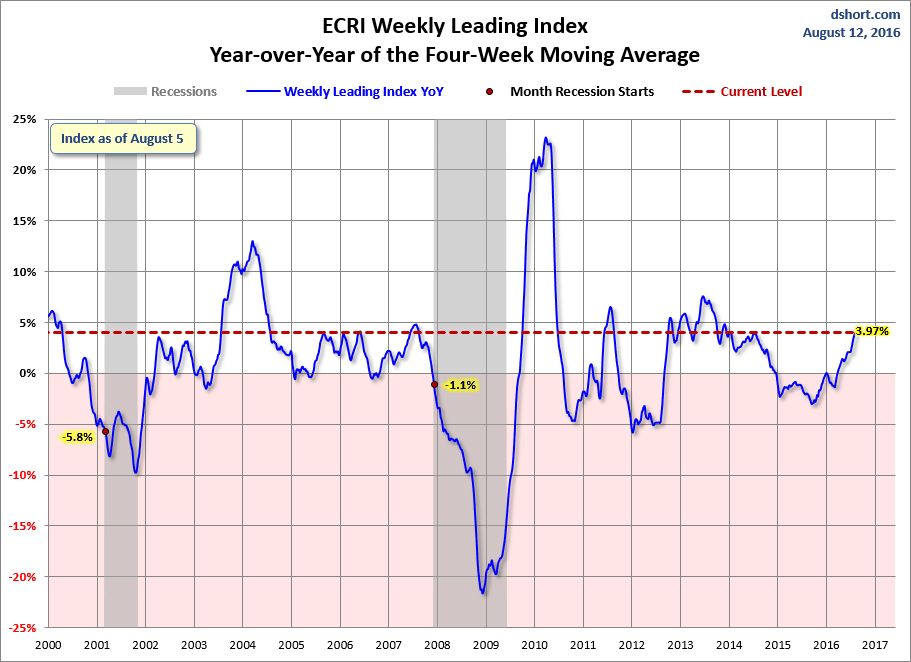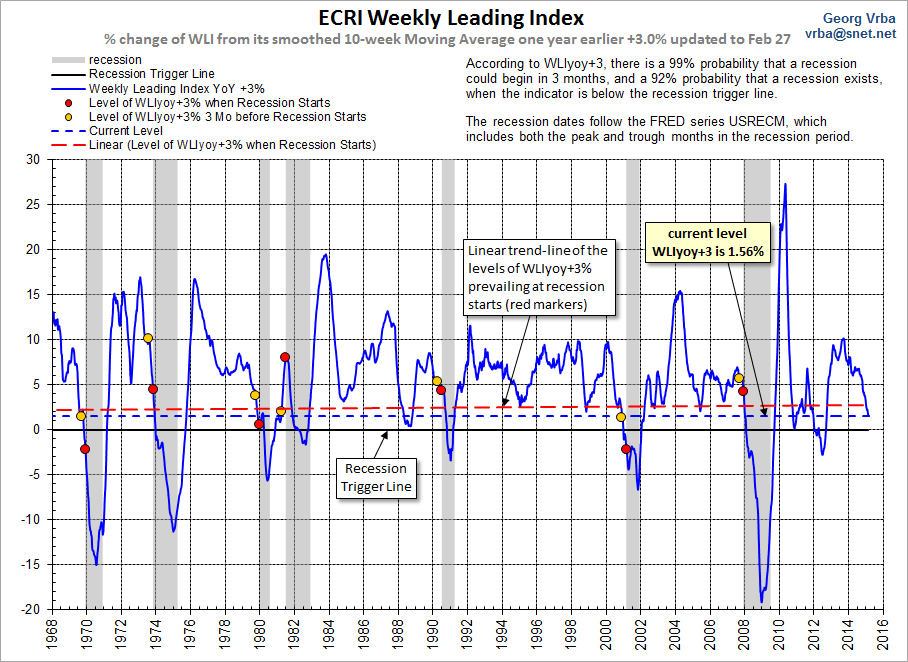. The WLI annualized growth indicator (WLIg) is at -5.0, unchanged to one decimal place from the previous week. The growth metric is hovering at its lowest level since January 2012. Falling Oil Prices and Bond Yields: No Surprise to ECRI The latest public news item on the ECRI website (unchanged from last week) includes a snapshot of the company’s Long Leading and Coincident Indexes of Global Growth. They remark that “The two biggest surprises for the markets in 2014 — falling oil prices and international bond yields — are completely consistent with ECRI’s cyclical call on global growth, and its prescient call on secular shifts in developed economies. Furthermore, when made, those forecasts were diametrically opposed to the consensus view.” See the complete commentary on ECRI’s website. The ECRI Indicator Year-over-Year Below is a chart of ECRI’s smoothed year-over-year percent change since 2000 of their weekly leading index. I’ve highlighted the 2011 date of ECRI’s original recession call and the hypothetical July 2012 business cycle peak, which the company previously claimed was the start of a recession. I’ve update the chart to include the “epicenter” (Achuthan’s terminology) of the hypothetical recession.
The first chart below shows the history of the Weekly Leading Index and highlights its current level. For a better understanding of the relationship of the WLI level to recessions, the next chart shows the data series in terms of the percent off the previous peak. In other words, a new weekly high registers at 100%, with subsequent declines plotted accordingly. As the chart above illustrates, only once has a recession ended without the index level achieving a new high — the two recessions, commonly referred to as a “double-dip,” in the early 1980s. Our current level is still off the most recent high, which was set back in June of 2007. We’ve exceeded the previously longest stretch between highs, which was from February 1973 to April 1978. But the index level rose steadily from the trough at the end of the 1973-1975 recession to reach its new high in 1978. The pattern in ECRI’s indictor is quite different, and this has no doubt been a key factor in their business cycle analysis. The WLIg Metric The best known of ECRI’s indexes is their growth calculation on the WLI. For a close look at this index in recent months, here’s a snapshot of the data since 2000. Now let’s step back and examine the complete series available to the public, which dates from 1967. ECRI’s WLIg metric has had a respectable record for forecasting recessions and rebounds therefrom. The next chart shows the correlation between the WLI, GDP and recessions. The History of ECRI’s Latest Recession Call ECRI’s weekly leading index has become a major focus and source of controversy ever since September 30, 2011, when ECRI publicly announced that the U.S. is tipping into a recession, a call the Institute had announced to its private clients on September 21st. Here is an excerpt from the announcement:
Year-over-Year Growth in the WLI Triggered by another ECRI commentary, Why Our Recession Call Stands, I include a snapshot of the year-over-year growth of the WLI rather than ECRI’s previously favored method of calculating the WLIg series from the underlying WLI (see the endnote below). Specifically the chart immediately below is the year-over-year change in the 4-week moving average of the WLI. The red dots highlight the YoY value for the month when recessions began. The WLI YoY has gone deeper into the negative zone, now at -2.4%. This is a new interim low and lower than the outset of five five seven recessions during ECRI’s published data series. This indicator has only rarely dipped below its current level outside recessionary periods: Lower levels occurred in 1988 and also during the economic volatility following the last recession. Additional Sources for Recession Forecasts Dwaine van Vuuren, CEO of RecessionAlert.com, and his collaborators, including Georg Vrba and Franz Lischka, have developed a powerful recession forecasting methodology that shows promise of making forecasts with fewer false positives, which I take to include excessively long lead times, such as ECRI’s September 2011 recession call. Here is today’s update of Georg Vrba’s analysis, which is explained in more detail in this article. Earlier Video Chronology of ECRI’s Recession Call
Note: How to Calculate the Growth series from the Weekly Leading Index ECRI’s weekly Excel spreadsheet includes the WLI and the Growth series, but the latter is a series of values without the underlying calculations. After a collaborative effort by Franz Lischka, Georg Vrba, Dwaine van Vuuren and Kishor Bhatia to model the calculation, Georg discovered the actual formula in a 1999 article published by Anirvan Banerji, the Chief Research Officer at ECRI: ” The three Ps: simple tools for monitoring economic cycles – pronounced, pervasive and persistent economic indicators.” Here is the formula:
|










